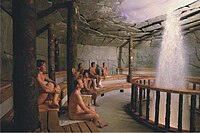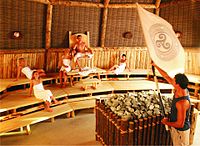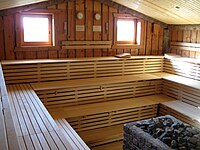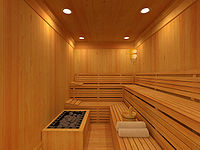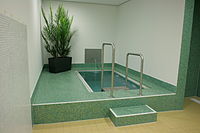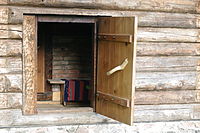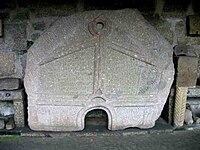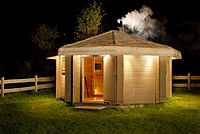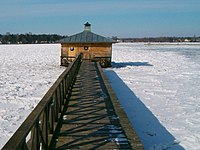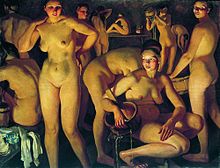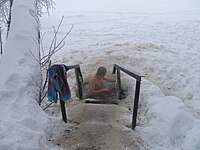Contact SoCal Sauna at 951-741-1048 and please visit our website at www.socalsauna.com for a NO COST consultation to make sure you get the right sauna!
Sauna
From Wikipedia, the free encyclopedia
For other uses, see Sauna (disambiguation).
A sauna (/ˈsɔːnə/ [1] or /ˈsaʊnə/;[2][3] Finnish pronunciation: [ˈsɑunɑ]) is a small room or building designed as a place to experience dry or wet heat sessions, or an establishment with one or more of these facilities. The steam and high heat make the bathers perspire. Saunas can be divided into two basic types: conventional saunas that warm the air or infrared saunas that warm objects. Infrared saunas may use a variety of materials in their heating area such as charcoal, active carbon fibers, and other materials.
Etymology
Originally borrowed from the early Proto-Germanic *stakna- whose descendants include English stack, the word sauna is an ancient Finnish word referring to the traditional Finnish bath and to the bathhouse itself. In Baltic-Finnic languages other than Finnish, sauna does not necessarily mean a building or space built for bathing. It can also mean a small cabin or cottage, such as a cabin for a fisherman.[4]
History
In Mexico and Central America, more specifically in the highlands of central and southern Mexico and Guatemala, there is a version of the sauna indigenous to the Americas, called a temazcal. It is the Mexican, Central American version of the sweat lodge used by indigenous peoples of the Americas, though the temazcal is usually made of clay or stone rather than wood.
Archeological sites in Greenland and Newfoundland have uncovered structures very similar to traditional Scandinavian farm saunas, some with bathing platforms and "enormous quantities of badly scorched stones".[5]
In Europe, the Nordic countries have a sauna tradition. The Finnish sauna culture is well established; there are built-in-saunas in almost every house in Finland.[6] The oldest known saunas in Finland were made from pits dug in a slope in the ground and primarily used as dwellings in winter. The sauna featured a fireplace where stones were heated to a high temperature. Water was thrown over the hot stones to produce steam and to give a sensation of increased heat. This would raise the apparent temperature so high that people could take off their clothes. The first Finnish saunas are what nowadays are called savusaunas, or smoke saunas.[7] These differed from present-day saunas in that they were heated by heating a pile of rocks called kiuas by burning large amounts of wood about 6 to 8 hours, and then letting the smoke out before enjoying the löyly, or sauna heat. A properly heated "savusauna" gives heat up to 12 hours.[8]
As a result of the Industrial Revolution, the sauna evolved to use a metal woodstove, or kiuas [ˈkiu.ɑs], with a chimney. Air temperatures averaged around 70–90 °C (158–194 °F) but sometimes exceeded 100 °C (212 °F) in a traditional Finnish sauna. When the Finns migrated to other areas of the globe they brought their sauna designs and traditions with them. This led to further evolution of the sauna, including the electric sauna stove, which was introduced in 1938 by Metos Ltd in Vaasa [9] and far infrared saunas, which have gained some popularity in the last several decades. Although the culture of sauna nowadays is more or less related to Finnish culture, the evolution of sauna happened around the same time both in Finland and the Baltic countries sharing the same meaning and importance of sauna in daily life, shared still to this day.
Modern saunas
Under many circumstances, temperatures approaching and exceeding 100 °C (212 °F) would be completely intolerable. Saunas overcome this problem by controlling the humidity. The hottest Finnish saunas have relatively low humidity levels in which steam is generated by pouring water on the hot stones. This allows air temperatures that could boil water to be tolerated and even enjoyed for longer periods of time. Steam baths, such as the Turkish bath, where the humidity approaches 100%, will be set to a much lower temperature of around 40 °C (104 °F) to compensate. The "wet heat" would cause scalding if the temperature were set much higher.
In a typical Finnish sauna, the temperature of the air, the room and the benches is above the dew point even when water is thrown on the hot stones and vaporized. Thus, they remain dry. In contrast, the sauna bathers are at about 38 °C (100 °F), which is below the dew point, so that water is condensed on the bathers' skin. This process releases heat and makes the steam feel hot.
Finer control over the temperature experienced can be achieved by choosing a higher level bench for those wishing a hotter experience or a lower level bench for a more moderate temperature. A good sauna has a relatively small temperature gradient between the various seating levels. Doors need to be kept closed and used quickly to maintain the temperature inside.
Some North American, Western European, Japanese, Russian and South African public sport centres and gyms include sauna facilities. They may also be present at public and private swimming pools.
As an additional facility a sauna may have one or more jacuzzis. In some spa centres there are the so-called special "snow rooms." Also known as a cold sauna or cryotherapy it works as a way to draw blood flow into the body core and stimulate the bodies white blood cells to help fight disease much the same way a hot sauna does. Operating at a temperature of -110 degrees the user is in the sauna for a period of only about 3 minutes.[clarification needed]
Use
A steam sauna can take 30 minutes to heat up when first started. Some users prefer taking a warm shower beforehand to speed up perspiration in the sauna. When in the sauna users often sit on a towel for hygiene and put a towel over the head if the face feels too hot but the body feels comfortable. In Russia, a felt "banya hat" may be worn to shield the head from the heat; this allows the wearer to increase the heat on the rest of the body.
Most adjustment of temperature in a sauna comes from,
- amount of water thrown on the heater, this increases humidity, so that sauna bathers perspire more copiously.
- length of stay in the sauna
- positioning when in the sauna
Heating caused by direct radiation will be greatest closest to the stove. Heating from the air will be lower on the lower benches as the heat rises. Provided the sauna is not crowded, lying on a bench is considered preferable as it gives more even temperature over the body. Heating caused by fresh steam can be very different in different parts of the sauna. As the steam rises directly upwards it will spread across the roof and travel out towards the corners, where it will then be forced downwards. Consequently, the heat of fresh steam may sometimes be felt most strongly in the furthest corners of the sauna. Users increase duration and the heat gradually over time as they adapt to sauna.[10][11]
When pouring water onto the heater, it will cool down the heater, but carry more heat into the air via advection, making the sauna warmer.
Perspiration is a sign of autonomic responses trying to cool the body. Users are advised to leave the sauna if the heat becomes unbearable, or if they feel faint or ill. Some saunas have a thermostat to adjust temperature, but management and other users expect to be consulted before changes are made. The sauna heater and rocks are very hot—one must stay well clear to avoid injury, particularly when water is poured on the sauna rocks, which creates an immediate blast of steam. Combustibles on or near the heater have been known to result in fire. Contact lenses dry out in the heat. Jewellery or anything metallic, including glasses, will get hot in the sauna and can cause discomfort or burning.[10][11]
Temperature on different parts of the body can be adjusted by shielding from the steam radiator with a towel. Shielding the face with a towel has been found to reduce the perception of heat.[12][13] It may be advisable to put an additional towel or special cap on the hair to avoid dryness. Few people can sit directly in front of the heater without feeling too hot from radiant heat, but their overall body temperature may be insufficient. As the person’s body is often the coolest object in a sauna room, steam will condense into water on the skin; this can be confused with perspiration.
In an infrared dry sauna, the heaters produce infrared rays that superficially heat skin and other exposed surfaces but not the air.[14] For safety reasons water is not placed on these types of heaters.
Cooling down is a part of the sauna cycle and is as important as the heating. Among users it is considered good practice to take a few moments after exiting a sauna before entering a cold plunge, and to enter a plunge pool by stepping into it gradually, rather than immediately immersing fully. In summer, a session is often started with a cold shower.[11][15]
Therapeutic sauna has been shown to aid adaptation, reduce stress hormones, lower blood pressure and improve cardiovascular conditions.[16][17][18][19][20][21]
Finnish sauna
Main article: Finnish sauna
A sauna session can be a social affair in which the participants disrobe and sit or recline in temperatures typically between 70 and 100 °C (158 and 212 °F). This induces relaxation and promotes sweating. The Finns use a bundle of birch twigs with fresh leaves, to gently slap the skin and create further stimulation of the pores and cells.[7]
The sauna was (and still is) an important part of daily life, and families bathed together in the home sauna. There are at least 2 million saunas according to official registers. Finnish Sauna Society believes the number can actually be as high as 3.2 million saunas (population 5.4 million).[citation needed]
Technologies
Today there are a wide variety of sauna options. Heat sources include wood, electricity, gas and other more unconventional methods such as solar power. There are wet saunas, dry saunas, smoke saunas, steam saunas, and those that work with infrared waves. There are two main types of stoves: continuous heating and heat storage-type. Continuously heating stoves have a small heat capacity and can be heated up on a fast on-demand basis, whereas a heat storage stove has a large heat (stone) capacity and can take much longer to heat.
Heat storage-type
Smoke sauna
Smoke sauna (Finnish savusauna, Estonian suitsusaun, Võro savvusann) is one of the earliest forms of the sauna. It is simply a room containing a pile of rocks, but without a chimney. A fire is lit directly under the rocks and after a while the fire is extinguished. The heat retained in the rocks, and the earlier fire, becomes the main source for heating the sauna. Following this process, the ashes and embers are removed from the hearth, the benches and floor are cleaned, and the room is allowed to air out and freshen for a period of time. The smoke deposits a layer of soot on every surface, so if the benches and back-rests can be removed while the fire is alight the amount of cleaning necessary is reduced. Depending on size of the stove and the airing time, the temperature may be low, about 60 °C (140 °F), while the humidity is relatively high. The tradition almost died out, but was revived by enthusiasts in the 1980s. These are still used in present-day Finland by some enthusiasts, but usually only on special occasions such as Christmas, New Year's, Easter, and juhannus (Midsummer).[8]
Heat storage-sauna
The smoke-sauna stove is also used with a sealed stone compartment and chimney (a heat storage-stove) which eliminates the smoke odour and eye irritation of the smoke sauna. A heat storage stove does not give up much heat in the sauna before bathing since the stone compartment has an insulated lid. When the sauna bath is started and the löyly shutter opened a soft warmth flow into the otherwise relatively cold (60 °C; 140 °F) sauna. This heat is soft and clean because, thanks to combustion, the stove stones glow red, even white-hot, and are freed of dust at the same time. When bathing the heat-storage sauna will become as hot as a continuous fire type-sauna (80–110 °C; 176–230 °F) but more humid. The stones are usually durable heat proof and heat-retaining peridotite. The upper part of the stove is often insulated with rock wool and firebricks. Heat-storing stoves are also found with electric heating, with similar service but no need to maintain a fire.
Continuous heat-type
Continuous fire sauna
A continuous fire stove, instead of stored heat, is a relatively recent invention. There is a firebox and a smokestack, and stones are placed in a compartment directly above the firebox. It takes shorter time to heat than the heat storage-sauna, about one hour. A fire-heated sauna requires manual labor in the form of maintaining the fire during bathing; the fire can also be seen as a hazard.
Fire-heated saunas are common in cottages, where the extra work of maintaining the fire is not a problem.
Electric stove sauna
The most common modern sauna types are those with electric stoves. The stones are heated up and kept on temperature using electric heating elements. There is thermostat and a timer (eight hour maximum continuous heating time) on the stove. This type of heating is used in urban saunas.
Similar sweat bathing facilities
Many cultures have sweat baths, though some have more spiritual uses while others are purely secular. These include: In Africa, the sifutu. The Turkish or Arab hammam. In Ancient Rome there was the thermae. In the Americas there is the Nahuatl (Aztec) temāzcalli [temaːsˈkalːi],Maya zumpul-ché, and the Mixtec Ñihi; and, in Canada and the United States, a number of First Nations and Native American cultures have various kinds of spiritual sweat lodges (Lakota: inipi, Anishinaabemowin: madoodiswan). In Europe we find the Russian banya, Estoniansaun, the Jewish shvitz, and the Swedish bastu. In Asia the Japanese Mushi-Buro and the Korean jjimjilbang. The Karo people of Indonesiahave the oukup.
Modern sauna culture around the world
Africa
In Africa, the majority of sauna facilities are found in more upmarket Hotel, Spa and Health Club environments and predominantly share both Sauna heater technology and design concepts as applied in Europe. Even though outdoor temperatures remain warmer and more humid, this does not affect the general application or intended sauna experience offered within these commercial environments offering a traditional sauna and or steam shower experience.
Asia
In Iran, most gyms, hotels and almost all public swimming pools have indoor saunas. It is very common for swimming pools to have two saunas which are known in Persian as "سونای خشک" dry sauna & "سونای بخار" steam sauna, with the dry type customarily boasting a higher temperature. A cold water pool (and/or more recently a cold jacuzzi) is almost always accompanied and towels are usually provided. Adding therapeutic or relaxing essential oils to the rocks is common. In Iran, unlike Finland, sitting in sauna is mostly seen as part of the spa/club culture, rather than a bathing ritual. It is most usually perceived as a means for relaxation or detoxification (through perspiration). Having a sauna room on a private property is considered a luxury rather than a necessity. Public saunas are segregated and nudity is prohibited.
In Japan, many saunas exist at sports centers and public bathhouses (sentō). The saunas are almost always gender separated, often required by law, and nudity is a required part of proper sauna etiquette. While right after World War II, public bathhouses were commonplace in Japan, the number of customers have dwindled as more people were able to afford houses and apartments equipped with their own private baths as the nation became wealthier. As a result, many sentōs have added more features such as saunas in order to survive.
In Korea, saunas are essentially public bathhouses. Various names are used to describe them, such as the smaller mogyoktang, outdoor oncheon, and the elaborate jjimjilbang. The word 'sauna' is used a lot for its 'English appeal', however it does not strictly refer to the original Fennoscandian steam rooms that have become popular throughout the world. The konglish word sauna (사우나) usually refers to bathhouses with Jacuzzis, hot tubs, showers, steam rooms, and related facilities.
Australia and Canada
See also: German Australian
In Australia and Canada, saunas are found mainly in hotels, swimming pools, and health clubs and if used by both men and women, nudity is forbidden. In gyms or health clubs with separate male and female change rooms, nudity is permitted, however members are usually asked to shower before using the sauna and to sit on a towel.
Europe
Dutch-speaking regions
Public saunas can be found throughout the Netherlands and Flanders, both in major cities and in smaller municipalities, mixed-gender nudity is the generally accepted rule. In the Netherlands and Flanders, saunas frequently offer women-only (or "bathing suit only") times for people who are less comfortable with mixed-gender nudity; Algemeen Dagbladreported in 2008 that women-only, bathing suit-required times are drawing Muslim women to the sauna.[22]
France, the United Kingdom and Mediterranean Europe
In France, the United Kingdom and much of Southern Europe, single-gender saunas are the most common type. Nudity is expected in the segregated saunas but usually forbidden in the mixed saunas. This is a source of confusion when residents of these nations visit Germany and Austria or vice versa. Sauna sessions tend to be shorter and cold showers are shunned by most. In the United Kingdom, where public saunas are becoming increasingly fashionable, the practice of alternating between the sauna and the jacuzzi in short seatings (considered afaux pas in Northern Europe) has emerged. Foreign visitors should also be aware that some small establishments advertised as 'saunas' are in fact brothels and it is rare to have a legitimate sauna with no other health spa or gym facilities in the UK.[citation needed]
In Portugal, the steam baths were commonly used by the Castrejos people, prior to the arrival of the Romans in the western part of the Iberian Peninsula. The historian Estrabão (Portuguese Wikipedia) spoke of Lusitans traditions that consisted of having steam bath sessions followed by cold water baths. Pedra Formosa is the original name given to the central piece of the steam bath in pre-Roman times.[citation needed]
In French-speaking Switzerland, customs are less rigid. Often, patrons have their choice of bathing nude or clothed. Other facilities offer nude single-sex saunas, nude mixed-gender saunas and clothed mixed-gender saunas on the same premises.
German-speaking countries
In Germany, Austria, Luxembourg and South Tyrol (but rarely in the remainder of Italy), most public swimming pool complexes have sauna areas; in these locales, nudity is the generally accepted rule, and benches are expected to be covered by patrons' towels. These rules are strictly enforced in some public saunas. Separate single-sex saunas for both genders are rare, most places offer women-only and mixed-gender saunas, or organise women-only days for the sauna once a week. Loud conversation is not usual as the sauna is seen as a place of healing rather than socialising. Contrary to Russia and Nordic countries, pouring water on hot stones to increase humidity (Aufguss, lit: "Onpouring") is not normally done by the sauna visitors themselves; larger sauna areas have a person in charge (the Saunameister) for that, either an employee of the sauna complex or a volunteer. Aufguss sessions can take up to 10 minutes, and take place according to a schedule. During an Aufguss session the Saunameister uses a large towel to circulate the hot air through the sauna, intensifying sweating and the perception of heat. Once the Aufguss session has started it is not considered good manners to enter the sauna, as opening the door would cause loss of heat (Sauna guests are expected to enter the sauna just in time before the Aufguss. Leaving the session is allowed, but grudgingly tolerated). Aufguss sessions are usually announced by a schedule on the sauna door. An Aufguss session in progress might be indicated by a light or sign hung above the sauna entrance. Cold showers or baths shortly after a sauna, as well as exposure to fresh air in a special balcony, garden or open-air room (Frischluftraum) are considered a must.
In German-speaking Switzerland, customs are generally the same as in Germany and Austria, although you tend to see more families (parents with their children) and young people. Also in respect to socialising in the sauna the Swiss tend more to be like the Finns, Scandinavians or Russians. Also in German-speaking countries, there are many facilities for washing after using the sauna, with 'dunking pools' (pools of very cold water in which a person dips themselves after using the sauna) or showers. In some saunas and steam rooms, scented salts are given out which can be rubbed into the skin for extra aroma and cleaning effects.
Hungary
Hungarians see the sauna as part of a wider spa culture. Mixed genders use the sauna together and wear swimsuits. Single-sex saunas are rare, as well as those which tolerate nudity. Some Hungarian saunas have so-called "snow rooms" that look like little cages with snow and icicles, where visitors can cool down for a couple of minutes after each sauna session.
The Nordics, the North Baltic States, Russia and Eastern Europe
In Russophone nations the word banya (Russian: Баня) is widely used also when referring to a public bath; in Latvian, sauna is pirts, inLithuanian, sauna is pirtis, and in Swedish, sauna is bastu (< badstuga, "bath cabin"). Although cultures in all corners of the world have imported and adapted the sauna, many of the traditional customs have not survived the journey. Today, public perception of saunas, sauna "etiquette" and sauna customs vary hugely from country to country. In many countries sauna going is a recent fashion and attitudes towards saunas are changing, while in others traditions have survived over generations.
In Estonia, Latvia, Lithuania and Russia sauna-going plays a central social role. These countries boast the hottest saunas and the tradition of massaging fellow sauna-goers with leafy, wet birch bunches ('vasta' or 'vihta' in Finnish, 'viht' in Estonian, 'slota' in Latvian, 'vanta' in Lithuanian, 'веник' (venik) in Russian).
In Norway and Sweden saunas are found in many places, and are known as 'bastu' (from 'badstuga' = bath house). In Sweden, saunas are common in almost every public swimming pool and gym. The Public saunas are generally single-sex and it's often not permitted to use swimwear. When men and women use the sauna together in Sweden swimwear may sometimes be used.
In Russia, public saunas are strictly single-sex[citation needed], while in Finland, Estonia, Lithuania and Latvia, both types occur. During wintertime, Finns often run outdoors for either ice swimming or, in the absence of lake, just to roll around in the snow naked and then go back inside. This is popular in Estonia, Latvia, Lithuania and Russia as well. Finnish sauna is traditionally the same as Russian banya despite the popular misconception that Finnish sauna is very dry.
In ex-USSR there are three different types of saunas. The first one, previously very popular especially during the Soviet Era, is the public sauna or the banya, (also known as the Russian banya), as it is referred to among the locals, is similar in context to public bath houses in Russia and in all ex-Soviet nations. The banya is a large setting with many different rooms. There is at least one sauna (Finnish style), one cold pool of water, a relaxation area, another sauna where fellow-sauna goers beat other fellow-sauna goers with the leafy birch, a shower area, a small cafeteria with a TV and drinks, and a large common area that leads to the other areas. In this large area, there are marble bed-like structures where people lie down and receive a massage either by another sauna-member or by a designated masseur. In the resting area, there are also other bed-like structures made of marble or stone attached to the ground where people lie down to rest between different rounds of sauna or at the very end of their banya session. There is also a large public locker area where one keeps one's clothes as well as two other more private locker areas with individual doors that can lock these two separate locker rooms.
The second type of sauna is the Finnish sauna type one can find in any gym throughout the world or a hotel. It could be in the locker room or mixed (i.e. male and female together). Attitudes towards nudity are very liberal and people are less self-conscious about their nude bodies.
The third type of sauna is one that is rented by a group of friends. It is similar to the public banya bath house type, except that it is usually more modern and luxurious, and is often rented by groups of friends by the hour for the use of partying and socializing. Here it can be single-sex or mixed-sex.
Estonian sauna
Sauna traditions in Estonia are almost identical to Finland as saunas have traditionally held a central role in the life of an individual. Ancient Estonians believed saunas were inhabited by spirits. In folk tradition sauna was not only the place where one washed, but also used as the place where brides were ceremoniously washed, where women gave birth and the place the dying made their final bed.[23] The folk tradition related to the Estonian sauna is mostly identical to that surrounding the Finnish sauna. On New Year's Eve a sauna would be held before midnight to cleanse the body and spirit for the upcoming year.
North America and Central America
In the United States, the earliest saunas were Swedish bastus in the colony New Sweden around the Delaware River. The Swedish Governor at the time had a bathhouse on Tinicum Island.[5] Today sauna culture enjoys its greatest popularity in the Lake Superior Region, specifically the Upper Peninsula of Michigan, especially the Keweenaw Peninsula, and parts of Minnesota, Wisconsin, and Iowa, which are home to large populations of Swedish and particularly Finnish Americans. Duluth, Minnesota, at its peak, had as many as 14 public saunas.[5] Indeed, among Finnish farms in Great Lakes "sauna country", the cultural geographer Matti Kaups, found that 90% had sauna structures-more even than the farms in Finland. Elsewhere, sauna facilities are normally provided at health clubs and at hotels, but there is no tradition or ritual to their use. To avoid liability, many saunas operate at only moderate temperatures and do not allow pouring water on the rocks. A wider range of sauna etiquette is usually acceptable in the United States compared to other countries, with the exception that most mixed-sex saunas usually require some clothing such as a bathing suit to be worn. These are uncommon, however, as most saunas are either small private rooms or in the changing rooms of health clubs or gyms. There are few restrictions and their use is casual; bathers may enter and exit the sauna as they please, be it nude, with a towel, dripping wet in swimsuits or even in workout clothes (the latter being very unusual). Like many aspects of US culture, there are few prescribed conventions and the bather should remain astute to "read" the specific family or community's expectations. Besides the Finnish Americans, the older generation of Korean-Americans still uses the saunas as it is available to them. Sauna societies are beginning to emerge in colleges across America, with the first one being formed at Gustavus Adolphus College.
The Sweat lodge, used by many Native Americans as part of a spiritual ceremony, is a notable example of an indigenous sweating tradition. Unlike sauna traditions, and most forcefully in the case of the Inipi, the sweat lodge ceremonies have been robustly defended as an exclusively Native expression of spirituality rather than a recreational activity.[24][25]
Traditions and old beliefs
One word in Finnish, strictly connected to the sauna, is löyly. Steam vapour, also called löyly [ˈløyly], was created by splashing water on the heated rocks. (Löyly, pronounced [ˈløyly], can be understood as "sauna steam"). In many languages related to Finnish, a word corresponding to löyly is found. The same approximate meaning is used across the Finnic languages such as in Estonian leil. Originally this word meant "spirit" or "life", as in e.g. Hungarian lélek and Khanty lil, which both mean "soul", referring to the sauna's old, spiritual essence. There still exists an old Finnish saying, "saunassa ollaan kuin kirkossa," – one should behave in the sauna as in church.
The same meaning of "spirit" is also used in Latvian.
Saunatonttu, literally translated as "sauna elf", is a little gnome or tutelary spirit that was believed to live in the sauna. He was always treated with respect, otherwise he might cause much trouble for people. It was customary to warm up the sauna just for the tonttu every now and then, or to leave some food outside for him. It is said that he warned the people if a fire was threatening the sauna, or punished people who behaved improperly in it – for example slept, or played games, argued, were generally noisy or behaved otherwise "immorally" there. Such creatures are believed to exist in different cultures. The Russian banya has an entirely corresponding character called a bannik.
In Thailand, women spend hours in a makeshift sauna tent during a month following childbirth. The steam is typically infused with several herbs. It is believed that the sauna helps the new mother's body return to its normal condition more quickly.
Communal sweat lodges were commonplace in Ireland until the 19th century. The structure was a low stone mound with a small entrance. After the lodge was heated, participants entered and the door was sealed shut from the outside with a stone slab, typically for five hours before the participants were let out.
Health effects
In some countries the closest and most convenient access to a sauna is at a gymnasium. Some pool, major sport, and resort complexes also contain a sauna. Therapeutic sauna sessions are often carried out in conjunction with physiotherapy or hydrotherapy, gentle exercises that do not exacerbate symptoms.[26][27][28]
Sauna use may temporarily relieve symptoms of the common cold.[29][30] It increases the heat tolerance threshold and may improve performance in endurance sport.[31] Sauna may help rheumatic pain (with cold shower) but not neuropathic pain,[32] and has also shown usefulness for appetite loss and mild depression.[33] It has also been recommended for reducing symptoms in chronic fatigue syndromeand fibromyalgia,[34][35][36] and rheumatoid arthritis,[37] and for anorexia nervosa,[38] and been proposed for treatment of other conditions including glaucoma,[39] Sjogren syndrome,[40] and obstructive lung disease,[41] and for recuperation after childbirth. Many of the sauna therapeutic trials used a regular schedule of at least 5 days a week and often daily for one to three months, then several times a week for extended periods.[34][42][43]
Saunas may not be safe in cases of unstable angina pectoris, a recent heart attack,[44] and severe aortic stenosis.[citation needed]Additionally, there is risk of heat prostration or the even more serious hyperthermia. Children and older persons who have heart disease or seizure disorders or those who use alcohol or cocaine are especially vulnerable.[45] Sauna use has been associated with loss of fertility in men, lasting up to two months. There is evidence that the heat has dramatic effects on spermatogenesis.[46]
Prolonged stay in a sauna may lead to the loss of electrolytes from the body, as after vigorous exercise. The risk of dehydration leading to heat stroke may be reduced by regular sipping of water or isotonic drinks, but not alcohol, during the sauna. Sauna bathing and heavy drinking of alcoholic beverages, and also sauna bathing during alcohol withdrawal (hangover) phase can undoubtedly create real health risks.[10][47] In essentially all cases of death associated with saunas in Finland, the victim had diabetes, a heart condition or other serious chronic disease. More than 50% were men over the age of 50, and 30% were over 70. Most were also intoxicated.[48]
See also
- Aræotic
- Balneotherapy
- Banya
- Bathtub
- Body treatment
- Contrast shower
- Finnish sauna
- Hanjeungmak
- Hot spring
- Hot tub
- Hydrotherapy
- Mud bath
- Onsen
- Public bathing
- Public sauna in North West Europe
- Purification Rundown
- Spa
- Steambath
- Steam room
- Steam shower
- Sudatorium
- Sweat therapy
- Taiwanese hot springs
- Temazcal
- Thermae
- Thermal bath
- Turkish bath
- World Sauna Championships
References[edit]
- ^ "Sauna". The American Heritage Dictionary of the English Language. Houghton Mifflin. 2001.
- ^ Dictionary Reference: sauna
- ^ The Free Dictionary: sauna
- ^ Häkkinen, Kaisa (2004): Nykysuomen etymologinen sanakirja. WSOY: Helsinki. pp. 1131–1132
- ^ a b c Nordskog, M., Hautala, A (2010)The Opposite of Cold-The Northwoods Finnish Sauna Tradition; University of Minnesota Press
- ^ Finland in Figures, Buildings and summer cottages, Statistics Finland, 2011-06-22
- ^ a b Maki, Albert (20 September 2010). "New Finland Sauna / New Finlandin saunat".New Finland District. Saskatchewan Gen Web. Retrieved 17 April 2014.
- ^ a b Birt, Hazel Lauttamus (1988). "New Finland Homecoming 1888 - 1988" (republished online by Saskatchewan Gen Web Julia Adamson). Retrieved 7 December 2010.
- ^ Metos Ltd (in Finnish)
- ^ a b c "The sauna use" (PDF).
- ^ a b c "Bare facts of the sauna-thisisFINLAND".
- ^ Simmons SE, Mündel T, Jones DA; Mündel; Jones (September 2008). "The effects of passive heating and head-cooling on perception of exercise in the heat". Eur. J. Appl. Physiol. 104 (2): 281–8. doi:10.1007/s00421-007-0652-z. PMID 18172673.
- ^ Mündel T, Hooper PL, Bunn SJ, Jones DA; Hooper; Bunn; Jones (2006). "The effects of face cooling on the prolactin response and subjective comfort during moderate passive heating in humans". Exp. Physiol. 91 (6): 1007–14. doi:10.1113/expphysiol.2006.034629.PMID 16916892.
- ^ http://www.scribd.com/doc/6130705/Infrared-Radiation
- ^ Buguet A (2007). "Sleep under extreme environments: Effects of heat and cold exposure, altitude, hyperbaric pressure and microgravity in space". Journal of the Neurological Sciences 262 (1–2): 145–52. doi:10.1016/j.jns.2007.06.040. PMID 17706676.
- ^ Hannuksela ML, Ellahham S; Ellahham (2001). "Benefits and risks of sauna bathing". Am. J. Med. 110 (2): 118–26. doi:10.1016/S0002-9343(00)00671-9. PMID 11165553.
- ^ Kauppinen K (1997). "Facts and fables about sauna". Annals of the New York Academy of Sciences 813: 654–62. Bibcode:1997NYASA.813..654K. doi:10.1111/j.1749-6632.1997.tb51764.x. PMID 9100952.
- ^ Tsatsoulis A, Fountoulakis S; Fountoulakis (2006). "The protective role of exercise on stress system dysregulation and comorbidities". Annals of the New York Academy of Sciences 1083: 196–213. Bibcode:2006NYASA1083..196T.doi:10.1196/annals.1367.020. PMID 17148741.
- ^ McEwen BS (1998). "Stress, adaptation, and disease. Allostasis and allostatic load".Annals of the New York Academy of Sciences 840: 33–44.Bibcode:1998NYASA.840...33M. doi:10.1111/j.1749-6632.1998.tb09546.x.PMID 9629234.
- ^ McEwen BS (2000). "Allostasis and allostatic load: implications for neuropsychopharmacology". Neuropsychopharmacology 22 (2): 108–24.doi:10.1016/S0893-133X(99)00129-3. PMID 10649824.
- ^ Vuori I (1988). "Sauna bather's circulation". Ann. Clin. Res. 20 (4): 249–56.PMID 3218896.
- ^ Langendoen, Claudia (10 March 2008). "Moslima’s ontdekken badkledingsauna".Algemeen Dagblad (in Dutch). Retrieved 24 January 2014.
- ^ Ivar Paulson, The Old Estonian Folk Religion, Indiana University, 1971
- ^ Looking Horse, Arvol (16 October 2009), Concerning the deaths in Sedona, Indian Country Today Media Network, LLC
- ^ Mesteth, Wilmer, et al (June 10, 1993) "Declaration of War Against Exploiters of Lakota Spirituality." "At the Lakota Summit V, an international gathering of US and Canadian Lakota, Dakota and Nakota Nations, about 500 representatives from 40 different tribes and bands of the Lakota unanimously passed a "Declaration of War Against Exploiters of Lakota Spirituality." The following declaration was unanimously passed."
- ^ Sohr C (March 1983). "[Physio and balneotherapy of acral circulatory disorders and cutaneous microangiopathies]". Z Gesamte Inn Med (in German) 38 (6): 207–13.PMID 6603073.
- ^ Kaszubowski U (January 1981). "[Physiotherapy in recurring urinary calculus formation and chronic inflammatory kidney and urinary tract diseases]". Z Urol Nephrol (in German)74 (1): 51–6. PMID 7234155.
- ^ Bender T, Nagy G, Barna I, Tefner I, Kádas E, Géher P; Nagy; Barna; Tefner; Kádas; Géher (July 2007). "The effect of physical therapy on beta-endorphin levels". Eur. J. Appl. Physiol. 100 (4): 371–82. doi:10.1007/s00421-007-0469-9. PMID 17483960.
- ^ Ernst E (1990). "[Hardening against the common cold – is it possible?]". Fortschr. Med.(in German) 108 (31): 586–8. PMID 2258128.
- ^ Ernst E, Pecho E, Wirz P, Saradeth T; Pecho; Wirz; Saradeth (1990). "Regular sauna bathing and the incidence of common colds". Annals of Medicine 22 (4): 225–7.doi:10.3109/07853899009148930. PMID 2248758.
- ^ Scoon GS, Hopkins WG, Mayhew S, Cotter JD; Hopkins; Mayhew; Cotter (2007). "Effect of post-exercise sauna bathing on the endurance performance of competitive male runners". Journal of science and medicine in sport / Sports Medicine Australia 10 (4): 259–62. doi:10.1016/j.jsams.2006.06.009. PMID 16877041.
- ^ Nurmikko T, Hietaharju A; Hietaharju (1992). "Effect of exposure to sauna heat on neuropathic and rheumatoid pain". Pain 49 (1): 43–51. doi:10.1016/0304-3959(92)90186-F. PMID 1375727.
- ^ Masuda A, Nakazato M, Kihara T, Minagoe S, Tei C; Nakazato; Kihara; Minagoe; Tei (2005). "Repeated thermal therapy diminishes appetite loss and subjective complaints in mildly depressed patients". Psychosomatic Medicine 67 (4): 643–7.doi:10.1097/01.psy.0000171812.67767.8f. PMID 16046381.
- ^ a b Masuda A, Kihara T, Fukudome T, Shinsato T, Minagoe S, Tei C; Kihara; Fukudome; Shinsato; Minagoe; Tei (April 2005). "The effects of repeated thermal therapy for two patients with chronic fatigue syndrome". J Psychosom Res 58 (4): 383–7.doi:10.1016/j.jpsychores.2004.11.005. PMID 15992574.
- ^ Masuda A, Munemoto T, Tei C; Munemoto; Tei (2007). "A new treatment: thermal therapy for chronic fatigue syndrome". Nippon Rinsho (in Japanese) 65 (6): 1093–8.PMID 17561703.
- ^ Schmidt KL (1991). "[Generalized tendomyopathy (fibromyalgia): differential diagnosis, therapy and prognosis]". Zeitschrift für die gesamte innere Medizin und ihre Grenzgebiete(in German) 46 (10–11): 370–4. PMID 1926943.
- ^ Matveĭkov GP, Marushchak VV; Marushchak (1993). "[An evaluation of the effect of the sauna on the clinical, laboratory and psychological indices in rheumatoid arthritis]". Ter. Arkh. (in Russian) 65 (12): 48–51. PMID 8146771.
- ^ Gutierrez E, Vazquez R; Vazquez (2001). "Heat in the treatment of patients with anorexia nervosa". Eating and weight disorders: EWD 6 (1): 49–52. doi:10.1007/bf03339752.PMID 11300546.
- ^ Mozaffarieh M, Flammer J; Flammer (2007). "A novel perspective on natural therapeutic approaches in glaucoma therapy". Expert Opinion on Emerging Drugs 12 (2): 195–8.doi:10.1517/14728214.12.2.195. PMID 17604496.
- ^ Tei C, Orihara FK, Fukudome T; Orihara; Fukudome (2007). "Remarkable efficacy of thermal therapy for Sjögren syndrome". Journal of Cardiology 49 (5): 217–9.PMID 17552286.
- ^ Cox NJ, Oostendorp GM, Folgering HT, van Herwaarden CL; Oostendorp; Folgering; Van Herwaarden (1989). "Sauna to transiently improve pulmonary function in patients with obstructive lung disease". Archives of physical medicine and rehabilitation 70 (13): 911–3.PMID 2596966.
- ^ Matsushita K, Masuda A, Tei C; Masuda; Tei (2008). "Efficacy of Waon therapy for fibromyalgia" (– Scholar search). Intern. Med. 47 (16): 1473–6.doi:10.2169/internalmedicine.47.1054. PMID 18703857. [dead link]
- ^ Winterfeld HJ, Siewert H, Strangfeld D, Warnke H, Kruse J, Engelmann U; Siewert; Strangfeld; Warnke; Kruse; Engelmann (August 1992). "[Potential use of the sauna in the long-term treatment of hypertensive cardiovascular circulation disorders - a comparison with kinesiotherapy]". Schweiz. Rundsch. Med. Prax. (in German) 81 (35): 1016–20.PMID 1410979.
- ^ Nagiev IuK (2003). "Duration-outcome relations in nonpharmacological treatment of chronic cardiac failure developed after acute myocardial infarction". Voprosy kurortologii, fizioterapii, i lechebnoĭ fizicheskoĭ kultury (in Russian) (3): 12–8. PMID 12852008.
- ^ Press E (August 1991). "The health hazards of saunas and spas and how to minimize them". Am J Public Health 81 (8): 1034–7. doi:10.2105/AJPH.81.8.1034.PMC 1405706. PMID 1853995.
- ^ Garolla, A; Torino, M; Sartini, B; Cosci, I; Patassini, C; Carraro, U; Foresta, C (2013). "Seminal and molecular evidence that sauna exposure affects human spermatogenesis".Human Reproduction 28 (4): 877–85. doi:10.1093/humrep/det020. PMID 23411620.
- ^ Ylikahri R, Heikkonen E, Soukas A; Heikkonen; Soukas (1988). "The sauna and alcohol".Ann. Clin. Res. 20 (4): 287–91. PMID 3218903.
- ^ "Suomessa kuolee saunaan kymmeniä vuodessa", Iltalehti, 17 June 2012 (Finnish)





